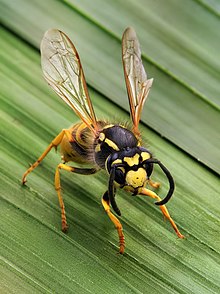Watch Video of this topic👉 Click here
In particular, bee stings are acidic, whereas wasp stings are alkaline, so the body's reaction to a bee sting may be very different than to that of a wasp sting.



The eustachian tube is a canal that connects the middle ear to the nasopharynx,
8.Which part of the brain plays an important role in motor control?
1) Cerebellum
2) Cerebrum
3) Medulla
4) Pons
10.'Agronomy' is the practice of raising ______________
1) Plants and Animals
2) Crop plants
3) Agriculture
4) Fruit plants only
1.A galvanometer can be converted to a voltmeter by connecting
1) a high resistance in parallel
2) a high resistance in series
3) a low resistance in series
4) a low resistance in parallel
2.Bee sting contains________________
1) An acidic liquid
2) a salt solution
3) an alkaline liquid
4) a corrosive liquid
1) a high resistance in parallel
2) a high resistance in series
3) a low resistance in series
4) a low resistance in parallel
2.Bee sting contains________________
1) An acidic liquid
2) a salt solution
3) an alkaline liquid
4) a corrosive liquid
In particular, bee stings are acidic, whereas wasp stings are alkaline, so the body's reaction to a bee sting may be very different than to that of a wasp sting.
What is wasp?

3.The outer most layer of Sun is known as___________
1) Chromosphere
2) Photosphere
3) Radioactive zone
4) Corona

4.Highest percentage of carbon is found in which form of coal?
1) Anthracite
2) Bituminous
3) Peat
4) lignite
1) Chromosphere
2) Photosphere
3) Radioactive zone
4) Corona

4.Highest percentage of carbon is found in which form of coal?
1) Anthracite
2) Bituminous
3) Peat
4) lignite
5.The xylem in plants are responsible for:
1) transport of water
2) transport of food
3) transport of amino acids
4) transport of oxygen

1) transport of water
2) transport of food
3) transport of amino acids
4) transport of oxygen
6.Which of the following bacterium causes crown gall disease in plants?
1) Bacillus thurigiensis
2) Agrobacterium tumefaciens
3) Pseudomonas fluorescens
4) None of these
1) Bacillus thurigiensis
2) Agrobacterium tumefaciens
3) Pseudomonas fluorescens
4) None of these
- Crown gall, plant disease, caused by the bacterium Agrobacterium tumefaciens (synonym Rhizobium radiobacter).
Symptoms
include roundish rough-surfaced galls (woody tumourlike growths), several
centimetres or more in diameter, usually at or near the soil line, on a graft site or bud union, or on roots and lower stems.
7.Eustachian Tube is located in which part of human body?
1) Nose
2) Ear
3) Eyes
4) Throat
1) Nose
2) Ear
3) Eyes
4) Throat

The eustachian tube is a canal that connects the middle ear to the nasopharynx,
which
consists of the upper throat and the back of the nasal cavity. It controls the
pressure within the middle ear, making it equal with the air pressure outside
the body.
8.Which part of the brain plays an important role in motor control?
1) Cerebellum
2) Cerebrum
3) Medulla
4) Pons
The cerebellum
is a region of the brain that plays an important role
in motor control. It may also be involved in some cognitive functions such
as attention and language, and in regulating fear and pleasure responses, but
its movement-related functions are the most solidly
established.
9.The frequency of direct current is _____________
1) Zero
2) 50 HZ
3) 60 HZ
4) 100 HZ
1) Zero
2) 50 HZ
3) 60 HZ
4) 100 HZ
AC is an alternating, always changing current source.
This means that the direction of the flow of current goes in
both directions within the wire, not at the same time, at some frequency,
like 60 Hz. DC is zero Hertz. So by said definition, it is
what it is. Steady State DC has no frequency.
10.'Agronomy' is the practice of raising ______________
1) Plants and Animals
2) Crop plants
3) Agriculture
4) Fruit plants only
Agronomy is a branch of
agricultural science that deals with the study of crops and the soils in which
they grow. Agronomists work to develop
methods that will improve the use of soil and increase the production of food
and fiber crops.


No comments:
Post a Comment